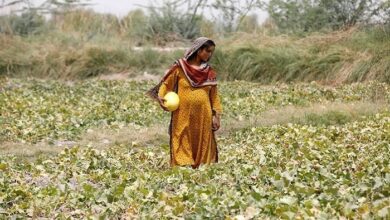ISLAMABAD: After a successful pilot project at 100 acres under China Pakistan Economic Corridor (CPEC), the next phase of Chilli farming will be ready for launch with upcoming sowing.
Referring to an article published by China Economic Net, CPEC Authority Chairman Lt Gen (r) Asim Saleem Bajwa on Sunday in a tweet said, the Chilli farming could spread over an area of 5000 acres in various regions of the country.
According to the article of China Economic Net, Pakistan has ideal conditions for Chilli/Pepper (Capsicum Annum L.) cultivation. Pakistan is amongst the top ten chilli producing nations which enjoy a combination of warm, humid yet dry weather and a well-drained sandy loam with rich organic content.
However, Pakistan’s chilli production has been lower than the world average for the same period since 2015. From FY2014–15 to FY2017-18, the average annual production of chilli in Pakistan was around 143,428 tons, but it plummeted to 126,943 tons in FY2018-19, accounting for 85.7% its peak in FY2017-18 of 148,114 tons.
In Pakistan, Sindh province is the major producer of chilli followed by Punjab and Balochistan. The major constraints in production faced by chilli farmers here are lack of modern irrigation system, imbalance use of fertilizer and pesticide, and lack of training.
“In Pakistan old methods of 1970s, 1960s or 1980s are adopted by farmers. Now Pakistan has to adopt modern technology to increase its production,” recommended Zahid Gishkori, a Special Investigative Correspondent in Pakistan.
What is worse, growers are troubled by some marketing issues, including unreasonable commission agent charges, improper weighing, price fluctuations and lack of proper storage facilities. Pepper growers are unable to make a proper profit from chilli due to marketing channel barriers.
Talking to China Economic Net, Khurum Javed Maqbool, Director Marketing of Fatima AG Soultions Limited, Pakistan, pointed out that at present the whole ecosystem in Pakistan is inefficient.
“From harvesting to sewing and storing of the crop and then selling it and then farmers getting financing and then the returns for their produce… All these operations require improvement.”
In July, a pilot Chilli farm project under the cooperation between Pakistani farmers and their Chinese partners – CMEC & Sichuan Litong Food Group – began to bear fruit, with a yield around 3 times Pakistani varieties.
Chen Changwei, Chairman of Sichuan Litong Food Group, China, noted that their pilot Chilli farm project successfully completed 100 acres of plantation in the first half of 2021 in Lahore.
For the 100-acre-pilot-project, the quantities of seeds are 380 grams per acre, with a yield reaching 3 tons per acre. The total production is expected to reach 300 tons.
While as per Ministry of National Food Security & Research (Economic Wing), chilli is grown on 47,349 hectares in Pakistan with a crop yield of about 2.68 tons per hectare (1.072 tons per acre) and an annual production of around 126,943 tons in FY2018-19.
As per Chen, they brought a total of 13 varieties of Chinese chillies to Pakistan since 2019. It took them three years to conduct the pilot program, and of all these 13 varieties, two varieties, namely, PJH-302 and PJH-407, have been certified for cultivation in Pakistan.
“Seed is the basic input for agriculture sector and has imperative role in enhancing agriculture productivity, food security and poverty alleviation,” said YEAR BOOK 2019-20 released by Ministry of National Food Security and Research (NFS&R), Pakistan.
On top of seeds, field management is also of great significance. Correct and careful management of farming and farmers could increase efficiency and reduce risk.
“We’re gonna arrange a team of 3 agricultural experts on each chilli field of around 0.165 acres,” Wu Guang told China Economic Net. And these agricultural experts will train Pakistani staff in planting technology.
Referring to an article published by China Economic Net, CPEC Authority Chairman Lt Gen (r) Asim Saleem Bajwa on Sunday in a tweet said, the Chilli farming could spread over an area of 5000 acres in various regions of the country.
According to the article of China Economic Net, Pakistan has ideal conditions for Chilli/Pepper (Capsicum Annum L.) cultivation. Pakistan is amongst the top ten chilli producing nations which enjoy a combination of warm, humid yet dry weather and a well-drained sandy loam with rich organic content.
However, Pakistan’s chilli production has been lower than the world average for the same period since 2015. From FY2014–15 to FY2017-18, the average annual production of chilli in Pakistan was around 143,428 tons, but it plummeted to 126,943 tons in FY2018-19, accounting for 85.7% its peak in FY2017-18 of 148,114 tons.
In Pakistan, Sindh province is the major producer of chilli followed by Punjab and Balochistan. The major constraints in production faced by chilli farmers here are lack of modern irrigation system, imbalance use of fertilizer and pesticide, and lack of training.
“In Pakistan old methods of 1970s, 1960s or 1980s are adopted by farmers. Now Pakistan has to adopt modern technology to increase its production,” recommended Zahid Gishkori, a Special Investigative Correspondent in Pakistan.
What is worse, growers are troubled by some marketing issues, including unreasonable commission agent charges, improper weighing, price fluctuations and lack of proper storage facilities. Pepper growers are unable to make a proper profit from chilli due to marketing channel barriers.
Talking to China Economic Net, Khurum Javed Maqbool, Director Marketing of Fatima AG Soultions Limited, Pakistan, pointed out that at present the whole ecosystem in Pakistan is inefficient.
“From harvesting to sewing and storing of the crop and then selling it and then farmers getting financing and then the returns for their produce… All these operations require improvement.”
In July, a pilot Chilli farm project under the cooperation between Pakistani farmers and their Chinese partners – CMEC & Sichuan Litong Food Group – began to bear fruit, with a yield around 3 times Pakistani varieties.
Chen Changwei, Chairman of Sichuan Litong Food Group, China, noted that their pilot Chilli farm project successfully completed 100 acres of plantation in the first half of 2021 in Lahore.
For the 100-acre-pilot-project, the quantities of seeds are 380 grams per acre, with a yield reaching 3 tons per acre. The total production is expected to reach 300 tons.
While as per Ministry of National Food Security & Research (Economic Wing), chilli is grown on 47,349 hectares in Pakistan with a crop yield of about 2.68 tons per hectare (1.072 tons per acre) and an annual production of around 126,943 tons in FY2018-19.
As per Chen, they brought a total of 13 varieties of Chinese chillies to Pakistan since 2019. It took them three years to conduct the pilot program, and of all these 13 varieties, two varieties, namely, PJH-302 and PJH-407, have been certified for cultivation in Pakistan.
“Seed is the basic input for agriculture sector and has imperative role in enhancing agriculture productivity, food security and poverty alleviation,” said YEAR BOOK 2019-20 released by Ministry of National Food Security and Research (NFS&R), Pakistan.
On top of seeds, field management is also of great significance. Correct and careful management of farming and farmers could increase efficiency and reduce risk.
“We’re gonna arrange a team of 3 agricultural experts on each chilli field of around 0.165 acres,” Wu Guang told China Economic Net. And these agricultural experts will train Pakistani staff in planting technology.






